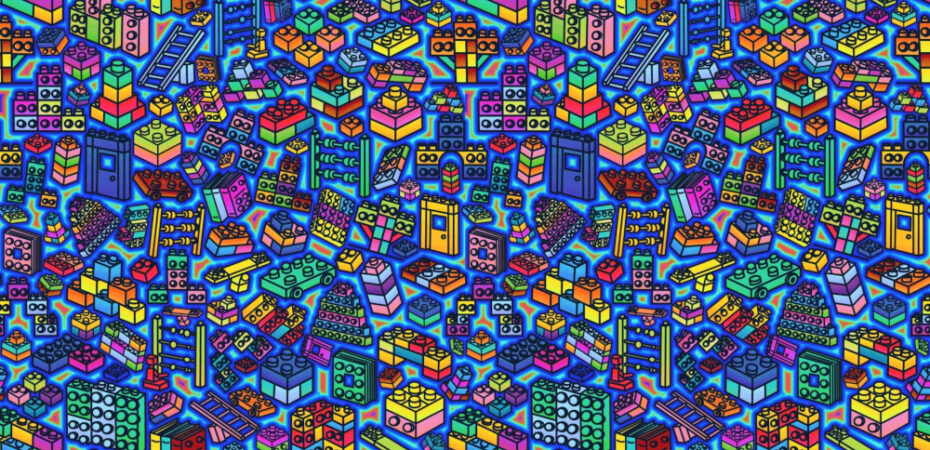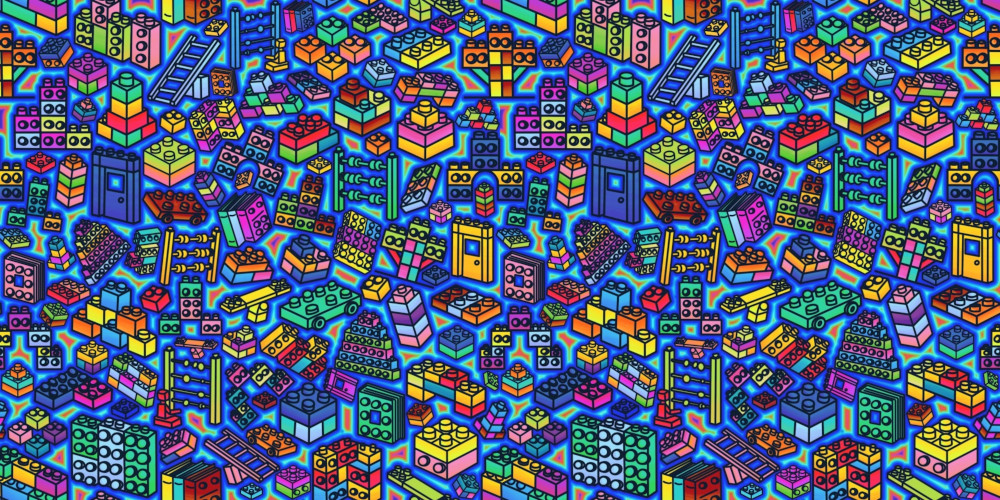
In this post, Dr Jane Hislop and Dr Simone Dimartino reflect on how LEGO® SERIOUS PLAY® (LSP) acts as a pedagogical approach that provides an alternative way of engaging learners. They describe how they used the LSP process to design and run a workshop as part of the Edinburgh Medical School’s Summer School in Clinical Education. This post belongs to the Engaging and Empowering Learning: Celebrating Best Practices series.
My journey with LEGO® SERIOUS PLAY® (LSP) began just as I was wondering what to do with a large box of my children’s outgrown LEGO® bricks and facing an environmental dilemma in potentially assigning more plastic waste to landfill. I was therefore both delighted and excited to discover a new and creative way of repurposing my LEGO® bricks having participated in a LSP workshop at the University of Edinburgh’s Learning and Teaching conference in June 2023.
Through the workshop, I met Simone Dimartino, Senior Lecturer and certified LEGO® SERIOUS PLAY® facilitator, who has embedded the use of LSP within their engineering degree programme. In conversation with Simone, I was to discover that LSP is a pedagogical approach which provides an alternative way of engaging learners, where they can connect and articulate personal meanings and express creative thought in a collaborative context through the process of making things (Gauntlett, 2011).
Developed in 1996, LSP was initially used in the business sector to encourage, “more engagement, imagination and playfulness in staff meetings” (Nolan, 2009 p365). However, it has since been used widely across the higher education sector as an innovative approach to encourage problem-solving and thinking in creative and imaginative ways (Hayes, 2016, James, 2013, McCusker, 2020). Through the creation of a symbolic 3-D model, the method draws on storytelling and the use of metaphor to create opportunities for ‘meaning making’, aligning with the philosophies of constructionism and constructivism, as well as drawing on flow theory and the hand-mind connection (Kristiansen and Rasmussen, 2014, Ajibade and Hayes, 2022). It is a particularly useful approach to constructing understanding around a topic where there is no one answer, and encourages listening to and valuing different perspectives, negating power imbalance in relation to the co-construction of knowledge (Ajibade and Hayes, 2022).
As a first step in using LSP, I worked with Simone to design a workshop as part of the Edinburgh Summer School in Clinical Education (ESSCE). ESSCE is a week-long course for 20-30 qualified healthcare professionals aimed at improving their knowledge and skills around clinical education. Together with Simone, we carefully crafted facilitator prompts to be used in the workshop. Each question was designed to bring all the participants into ‘flow’, and combine stimulating LEGO® construction activities together with individual sharing of the model with their group, open discussion at the table, and a final reflection element.
The ESSCE LSP session was designed around three ‘skills building’ stages. In the first, participants were asked to build a tower within a short timeframe (60 seconds in our case). This initial ‘warm-up’ allowed the participants to get their ‘hands-on’ the LEGO® blocks so as to familiarise themselves with the feel of the bricks, their bright colours and their assorted shapes. This stage is argued to be important as it provides reassurance for those apprehensive about using LEGO® (Bjørndahl et al., 2014). In our workshop, participants had varied experiences of LEGO® and I could see in this initial activity that the hesitation, trepidation, embarrassment and self-consciousness quickly give way to participants relaxing and immersing themselves into the construction activity (Flow theory in action- perhaps?). This construction element of tower building is captured in Fig. 1.
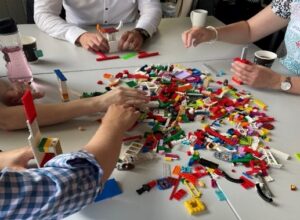
Following construction, each participant was given the opportunity to speak uninterrupted for a minute to their group about the features of their tower. As the tower was personal to them, there was no one right answer for the task. This provided a level playing field where everyone could be heard and listened to. The role of the group facilitator was to encourage non-judgemental appreciation and the creation of a comfortable, supportive and psychologically safe space where participants had an equality of voice when sharing ideas (McCusker, 2020).
Through subsequent building activities, the participants were introduced to the concept of using the LEGO® blocks as metaphors, for example, ‘this green block means safety in learning’. Participants were then encouraged to build structures making use of the blocks as metaphors, unleashing their imagination and creativity beyond the colour, shape or size of the LEGO® blocks. The process of metaphor meaning was personal, with the participants able to bring life into their thoughts thanks to their LEGO® model (McCusker and Swan, 2018). Examples of metaphors that can be drawn from a model are presented in Fig. 2.
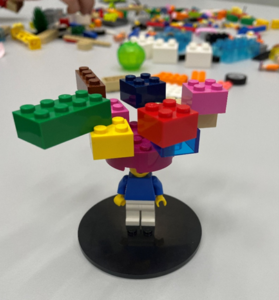
The final activity was around storytelling, prompting the participants to use the blocks to create a story about, “what an ideal learning environment looks like to you”. Drawing on past experiences, the participants created a narrative of what they see as important in creating a positive learning environment for their learners. The class facilitator used the feedback from the group discussion to draw out key ideas around learning and teaching and supporting learners in making meaning from their pre-existing knowledge (Hayes, 2016). An example of a LEGO® model from this exercise is showcased in Fig. 3. together with a potential narrative for the story being presented.
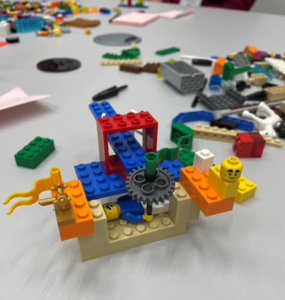
Feedback from participants’ of the ESSCE LSP workshop has been very positive:
“LEGO® session was a great way to communicate our different perspectives with each other, an interactive and social learning environment throughout, the day flew by”.
The LSP activity now forms an integral part of the ESSCE programme. As well as engaging our learners in discussion of concepts around learning, we hoped that, as educators themselves, our learners might take this approach forward into their own practice.
There are a few points for anyone considering this approach.
- While LSP facilitator training is recommended, the freely available open resource materials for LEGO® SERIOUS PLAY ® (Gauntlett, 2010) means that guidance on this approach is readily available.
- Access to LEGO® bricks: while many of us may not have LEGO® gathering dust in an attic, they can often be picked up cheaply second hand, either online or from a charity shop, which brings with it the added environmental benefit through repurposing what would become more unfortunate plastic waste.
- The final point which I learnt from Simone is that LSP is not an icebreaker; it needs careful planning and facilitation otherwise it will fall short of offering what can be an engaging and empowering educational experience for our learners.
*Note that these are not the original meanings from the participant, with the Lego model solely employed to exemplify the storytelling phase of LSP.
References
Biørndahl, J., Fusaroli, R., Østergaard, S., Tylén, K. (2014) Thinking together with material representations: Joint epistemic actions in creative problem solving. Cognitive Semiotics 7(1): 103-123.
Gauntlett, D. (2010) Open -Source: Introduction to LEGO® SERIOUS PLAY® Available at http://davidgauntlett.com/wp-content/uploads/2013/04/LEGO_SERIOUS_PLAY_OpenSource_14mb.pdf Accessed Nov, 29, 2024.
James, A. (2013) Lego Serious Play: a three-dimensional approach to learning development. Journal of Learning Development in Higher Education.(6) 1-18.
Kristiansen, P., Ramussen, R. (2014) Building a Better Business Using LEGO® SERIOUS PLAY® Method. Wiley, London.
McCusker, S. (2020) Everybody’s monkey is important LEGO® serious Play® as a methodology for enabling equality of voice within diverse groups. International Journal Research Methods Education. 1-17 https://doi.org/10.1080/1743727X.2019.1621831
McCusker, S., Swan, J.C. (2018) The Use of Metaphors With LEGO® SERIOUS PLAY® For Harmony And Innovation. International Journal of Management and Applied Research. 5 (4), 174-192.
Nolan, S. (2009) Physical Metaphorical Modelling with Lego as a Technology for Collaborative Personalised Learning in O’Donohue, J. (ed.) Technology-supported environments for personalized learning: methods and case studies. USA: Information Service Reference, pp. 364-385.
 Jane Hislop
Jane Hislop
Dr Jane Hislop is Director of the PG Certificate in Simulation Based Clinical Education and the Edinburgh Summer School in Clinical Education (ESSCE) and a Senior Lecturer on the MSc Clinical Education programme at Edinburgh Medical School. Jane teaches on online, distance learning programmes for those involved in health professions education (including qualified doctors, nurses, dentists, pharmacists, allied health professionals and veterinary professionals). In addition, Jane works part-time as a Clinical Education lead in Musculoskeletal Physiotherapy within NHS Fife Scotland. Jane has a particular interest in peer assessment and feedback as well as Simulation methodology. X: @hijanehislop
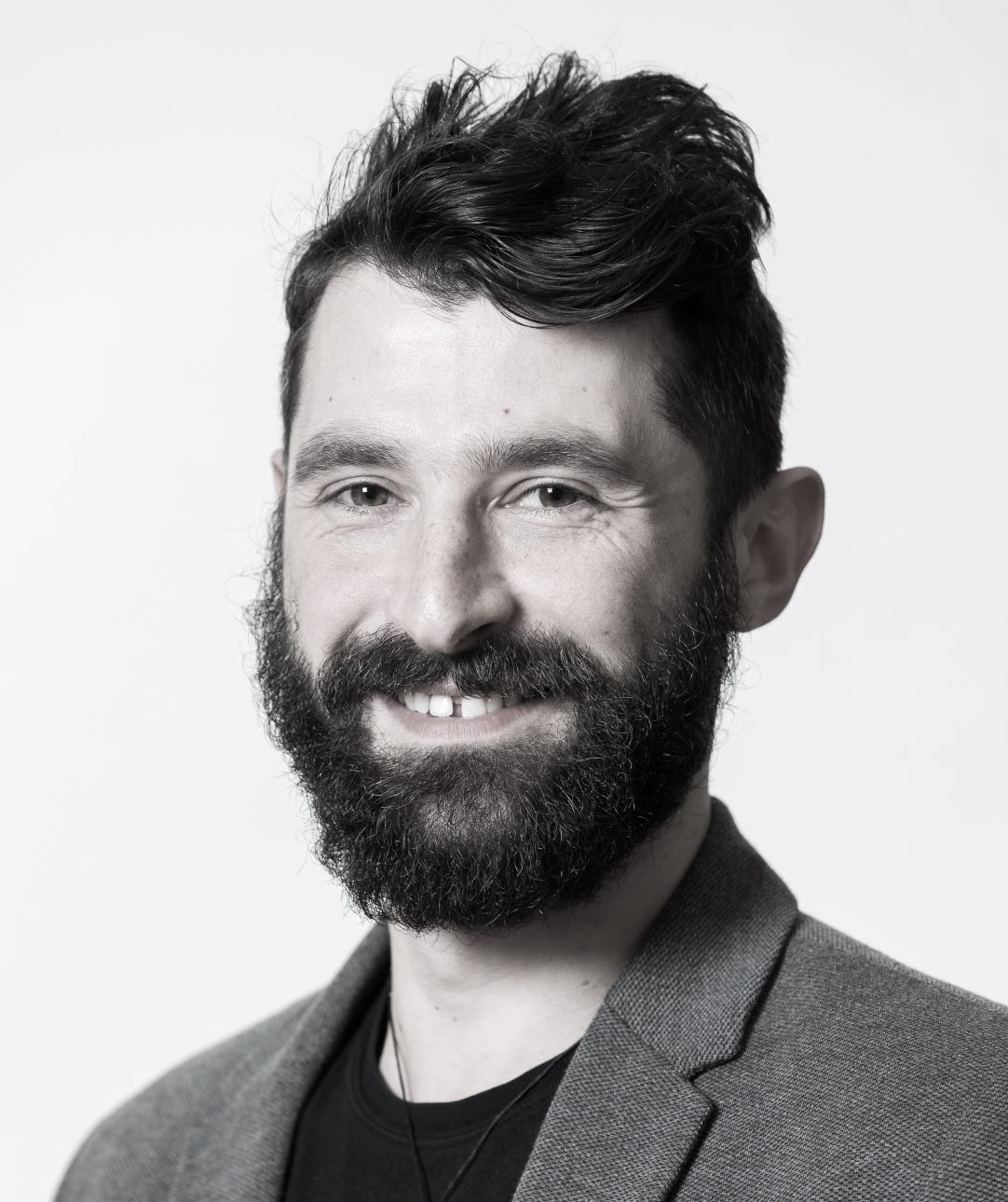 Simone Dimartino
Simone Dimartino
Simone Dimartino is a Senior Lecturer in the School of Engineering and a certified Lego Serious Play facilitator. His interests lie in experiential learning, particularly project-based approaches and integrating body and mind to enhance learning outcomes. He has extensive experience coordinating large, school-wide courses with over 500 students and designing innovative interdisciplinary learning spaces at scale (e.g., for over 2,000 students) and across diverse dimensions, from sustainability to pharmaceutical analysis.
Laura Weiner
Laura Weiner is a PhD Education candidate. Her research explores young people’s learning experiences in youth activism groups from a childhood and youth studies perspective. Her doctoral research specifically investigates how young activists conceptualise the skills, knowledge, and values important to their civic engagement, political participation, and social justice campaigns. Aside from her research, Laura has recently returned to her interest in art and has been experimenting with water colours, digital art, and pottery.

